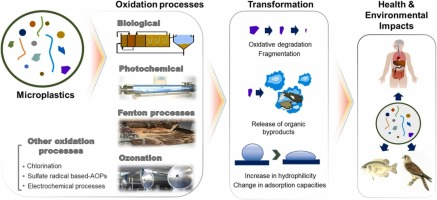Publication
Advanced Redox Technology Lab
Publication
Advanced Redox Technology Lab
Journal papers
Microplastics (MPs) are contaminants of emerging concern that accumulate in various environments, where they pose threats to both the ecosystem and public health. Since MPs have been detected in drinking water resources and wastewater effluents, more efficient treatment is needed at wastewater treatment plants (WWTPs) and drinking water treatment plants (DWTPs). This review discusses the potential of biological, photochemical, Fenton (-like) systems, ozonation, and other oxidation processes in the treatment of MPs in terms of their indicators of oxidation such as mass loss and surface oxidation. The oxidation processes were further analyzed in terms of limitations and environmental implications. Most previous studies examining MPs degradation using conventional treatments—such as UV disinfection, ozonation, and chlorination—employed significantly higher doses than the common doses applied in DWTPs and WWTPs. Owing to such dose gaps, the oxidative transformation of MPs observed in many previous studies are not likely to occur under practical conditions. Some novel oxidation processes showed promising MPs treatment efficiencies, while many of them have not yet been applied on a larger scale due to high costs and the lack of extensive basic research. Health and environmental impacts related to the discharge of oxidized MPs in effluents should be considered carefully in different aspects: the role as vectors of external pollutants, release of organic compounds (including organic byproducts from oxidation) and fragmentation into smaller particles as MPs circulate in the ecosystem as well as the possibility of bioaccumulation. Future research should also focus on ways to incorporate developed oxidation processes in DWTPs and WWTPs to mitigate MPs contamination.
